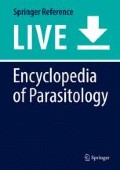Keywords
These keywords were added by machine and not by the authors. This process is experimental and the keywords may be updated as the learning algorithm improves.
The name acanthella (Figs. 1 and 2) has been attributed to the Acanthocephalan stage between the acanthor and the larva that is infective to the final (or paratenic) host (Cystacanth, Acanthocephala). Its growth begins under the serosa of the intermediate host and continues in its body cavity. The morphological changes from the acanthor that has survived the enclosure by the intermediate host’s hemocytes and detached itself from the intestinal wall to the late acanthella and the “cystacanth” are considerable, e.g., organogenesis occurs as well as a rotation of the worm’s axis through 90°, while the tegument of the acanthor becomes stretched to form the acanthella’s tegument. First, the central nuclear mass begins to split into different bodies which become the primordia of the organs.
Transmission electron micrograph of the outer part of a young acanthella and the surrounding spongy envelope (SE) of microvilli-like outgrowths of the larva’s surface. This envelope has not yet detached. A hemocyte (HC) of the intermediate host (a beetle) has invaded the envelope and come close to the worm with its pseudopodia (arrows); N nucleus of the hemocyte, SL striped layer of the developing tegument, ×3,500
Infective male larvae of (a) Acanthocephalus anguillae , (b) Filicollis anatis , (c) Moniliformis moniliformis . Note the progressing degree of encystment (from a to c) of the larvae parallel with a reduction in size and suppression of sexual organogenesis. Encystment seems to be an adaptation to the chewing or grinding activity of the final host (see Life Cycles). The larval envelopes (E) have been removed in a and b. The sausage-shaped larva of A. anguillae (A) has a very thin, closely fitting envelope. CG cement glands (1–6), E envelope, LE lemnisci, N neck, P proboscis (retracted), T tegument, TE testes
The acanthella’s tegument shows remarkable differentiation during the development in the arthropod’s hemocoel. Its outer membrane forms microvilli-like protuberances (Fig. 1, page 3) that build up a membranous spongelike envelope around the larva. Hemocytes can be found in it (Fig. 1), especially near early acanthellae and if the intermediate host is not entirely suitable. Later on the spongy vesicular cover becomes supplemented by a thin interior and an exterior layer of amorphous matter and detaches itself from the worm body, forming a gap of different width with an electron lucent granular matrix (probably liquid), Fig. 2 (page 4). Late acanthellae show everted proboscis; finally the proboscis becomes invaginated or the entire presoma as well as the posterior end is retracted, so that the larva appears in a cystlike shape (Cystacanth). This shape is common among species with definitive hosts that chew or grind their food in their upper intestinal tract (Fig. 2).
Author information
Authors and Affiliations
Corresponding author
Editor information
Editors and Affiliations
Rights and permissions
Copyright information
© 2015 Springer-Verlag Berlin Heidelberg
About this entry
Cite this entry
Mehlhorn, H. (2015). Acanthella. In: Mehlhorn, H. (eds) Encyclopedia of Parasitology. Springer, Berlin, Heidelberg. https://doi.org/10.1007/978-3-642-27769-6_12-2
Download citation
DOI: https://doi.org/10.1007/978-3-642-27769-6_12-2
Received:
Accepted:
Published:
Publisher Name: Springer, Berlin, Heidelberg
Online ISBN: 978-3-642-27769-6
eBook Packages: Springer Reference Biomedicine and Life SciencesReference Module Biomedical and Life Sciences



